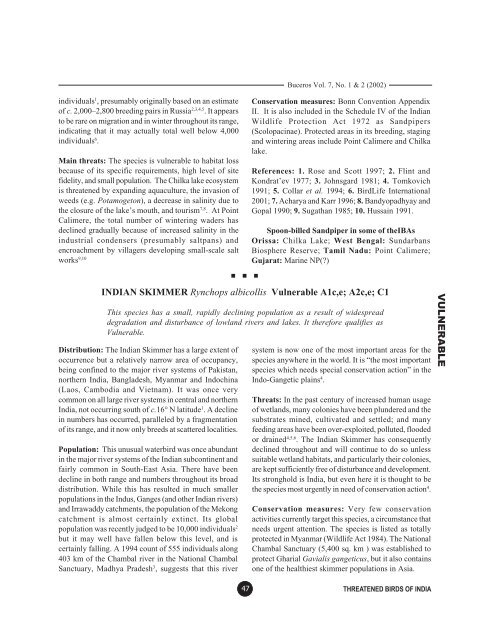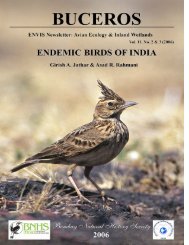Untitled - ENVIS Centre on Avian Ecology
Untitled - ENVIS Centre on Avian Ecology
Untitled - ENVIS Centre on Avian Ecology
Create successful ePaper yourself
Turn your PDF publications into a flip-book with our unique Google optimized e-Paper software.
individuals 1 , presumably originally based <strong>on</strong> an estimate<br />
of c. 2,000–2,800 breeding pairs in Russia 2,3,4,5 . It appears<br />
to be rare <strong>on</strong> migrati<strong>on</strong> and in winter throughout its range,<br />
indicating that it may actually total well below 4,000<br />
individuals 6 .<br />
Main threats: The species is vulnerable to habitat loss<br />
because of its specific requirements, high level of site<br />
fidelity, and small populati<strong>on</strong>. The Chilka lake ecosystem<br />
is threatened by expanding aquaculture, the invasi<strong>on</strong> of<br />
weeds (e.g. Potamoget<strong>on</strong>), a decrease in salinity due to<br />
the closure of the lake’s mouth, and tourism 7,8 . At Point<br />
Calimere, the total number of wintering waders has<br />
declined gradually because of increased salinity in the<br />
industrial c<strong>on</strong>densers (presumably saltpans) and<br />
encroachment by villagers developing small-scale salt<br />
works 9,10<br />
n n n<br />
Buceros Vol. 7, No. 1 & 2 (2002)<br />
C<strong>on</strong>servati<strong>on</strong> measures: B<strong>on</strong>n C<strong>on</strong>venti<strong>on</strong> Appendix<br />
II. It is also included in the Schedule IV of the Indian<br />
Wildlife Protecti<strong>on</strong> Act 1972 as Sandpipers<br />
(Scolopacinae). Protected areas in its breeding, staging<br />
and wintering areas include Point Calimere and Chilka<br />
lake.<br />
References: 1. Rose and Scott 1997; 2. Flint and<br />
K<strong>on</strong>drat’ev 1977; 3. Johnsgard 1981; 4. Tomkovich<br />
1991; 5. Collar et al. 1994; 6. BirdLife Internati<strong>on</strong>al<br />
2001; 7. Acharya and Karr 1996; 8. Bandyopadhyay and<br />
Gopal 1990; 9. Sugathan 1985; 10. Hussain 1991.<br />
Spo<strong>on</strong>-billed Sandpiper in some of theIBAs<br />
Orissa: Chilka Lake; West Bengal: Sundarbans<br />
Biosphere Reserve; Tamil Nadu: Point Calimere;<br />
Gujarat: Marine NP(?)<br />
INDIAN SKIMMER Rynchops albicollis Vulnerable A1c,e; A2c,e; C1<br />
This species has a small, rapidly declining populati<strong>on</strong> as a result of widespread<br />
degradati<strong>on</strong> and disturbance of lowland rivers and lakes. It therefore qualifies as<br />
Vulnerable.<br />
Distributi<strong>on</strong>: The Indian Skimmer has a large extent of<br />
occurrence but a relatively narrow area of occupancy,<br />
being c<strong>on</strong>fined to the major river systems of Pakistan,<br />
northern India, Bangladesh, Myanmar and Indochina<br />
(Laos, Cambodia and Vietnam). It was <strong>on</strong>ce very<br />
comm<strong>on</strong> <strong>on</strong> all large river systems in central and northern<br />
India, not occurring south of c.16° N latitude 1 . A decline<br />
in numbers has occurred, paralleled by a fragmentati<strong>on</strong><br />
of its range, and it now <strong>on</strong>ly breeds at scattered localities.<br />
Populati<strong>on</strong>: This unusual waterbird was <strong>on</strong>ce abundant<br />
in the major river systems of the Indian subc<strong>on</strong>tinent and<br />
fairly comm<strong>on</strong> in South-East Asia. There have been<br />
decline in both range and numbers throughout its broad<br />
distributi<strong>on</strong>. While this has resulted in much smaller<br />
populati<strong>on</strong>s in the Indus, Ganges (and other Indian rivers)<br />
and Irrawaddy catchments, the populati<strong>on</strong> of the Mek<strong>on</strong>g<br />
catchment is almost certainly extinct. Its global<br />
populati<strong>on</strong> was recently judged to be 10,000 individuals 2<br />
but it may well have fallen below this level, and is<br />
certainly falling. A 1994 count of 555 individuals al<strong>on</strong>g<br />
403 km of the Chambal river in the Nati<strong>on</strong>al Chambal<br />
Sanctuary, Madhya Pradesh 3 , suggests that this river<br />
system is now <strong>on</strong>e of the most important areas for the<br />
species anywhere in the world. It is “the most important<br />
species which needs special c<strong>on</strong>servati<strong>on</strong> acti<strong>on</strong>” in the<br />
Indo-Gangetic plains 4 .<br />
Threats: In the past century of increased human usage<br />
of wetlands, many col<strong>on</strong>ies have been plundered and the<br />
substrates mined, cultivated and settled; and many<br />
feeding areas have been over-exploited, polluted, flooded<br />
or drained 4,5,6 . The Indian Skimmer has c<strong>on</strong>sequently<br />
declined throughout and will c<strong>on</strong>tinue to do so unless<br />
suitable wetland habitats, and particularly their col<strong>on</strong>ies,<br />
are kept sufficiently free of disturbance and development.<br />
Its str<strong>on</strong>ghold is India, but even here it is thought to be<br />
the species most urgently in need of c<strong>on</strong>servati<strong>on</strong> acti<strong>on</strong> 4 .<br />
C<strong>on</strong>servati<strong>on</strong> measures: Very few c<strong>on</strong>servati<strong>on</strong><br />
activities currently target this species, a circumstance that<br />
needs urgent attenti<strong>on</strong>. The species is listed as totally<br />
protected in Myanmar (Wildlife Act 1984). The Nati<strong>on</strong>al<br />
Chambal Sanctuary (5,400 sq. km ) was established to<br />
protect Gharial Gavialis gangeticus, but it also c<strong>on</strong>tains<br />
<strong>on</strong>e of the healthiest skimmer populati<strong>on</strong>s in Asia.<br />
47 THREATENED BIRDS OF INDIA<br />
VULNERABLE




